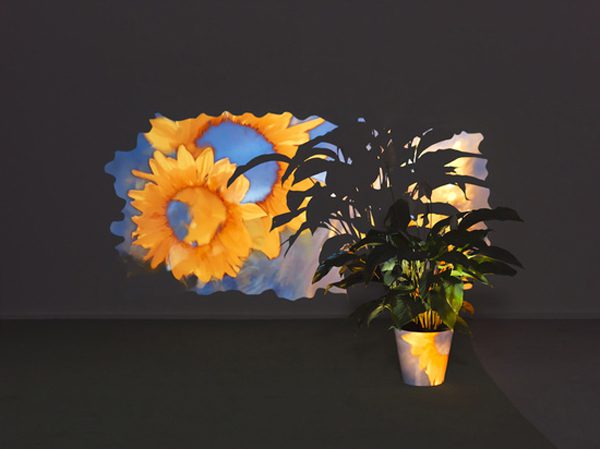Hauser & Wirth’s north gallery on Savile Row is a space that has been transformed in many possible ways, but this time the micro environment created for Pipilotti Rist’s show emerged as an unexpected -nevertheless pleasant- surprise. The entire gallery has been blacked out, carpeted and split into two sectors. At the reception area, where three smaller scale “introductory” video installations puts the audience in the mood for what is ahead, visitors are prompted to take their shoes off and proceed to the main section through a heavy denim curtain. There, white cosy duvets are scattered around the floor and everyone is free to use them as they please and relax while watching the video installation projected on the two large walls of the gallery.
Worry Will Vanish Horizon (2014), the title of the flagship video that lends its name to the entire exhibition, is a complex assemblage of imagery inspired from the human body and the natural world. It takes several seconds for the viewer to realise that the display is images taken from inside the body. Travelling like a surgeon’s laparoscopic camera through human organs and intestines, this is a slow motion roller coaster; occasionally meeting the surface and the skin, and then plunging back inside.
The simultaneous parading of snapshots from the natural world and the sporadic interweaving of images somehow generates a soothing, almost psychedelic, effect. Blood flow turns into sea waves, skin metamorphoses into tree leaves and so on. And, suddenly, the artist’s body emerges floating in a white virginal dress, adrift in a gravity-free habitat, swirling ceremonially within a diaphanous ocean, juxtaposed on a backdrop of human and natural wonders.
Watching the high-definition loop over and over again, beautifully commingled with the music of Anders Guggisberg, is a captivating almost addictive affair. It reminds the audience of an amalgamation of Allen Ginsberg’s poetics, the hippie subculture and new age music applications. Rist also based her video on principles of relaxation techniques such as that of autogenic training and psychotherapy. Developed by German psychiatrist Johannes Heinrich Schultz in the early 1930s, the practice embraced sessions with a series of visuals that promoted a state of relaxation and meditation, integrated with certain body postures such as that of lying down.
By involving her visitors in a similar situation, Rist wittingly confronts us with the sensual properties of our own hypostasis. Her narrative evokes the human existence from within, or even, inside out. She introduces us to our own self, a belated Lacanian mirror stage so to speak.
The exploration of esoteric landscapes, in literal and metaphorical domains, has been one of Rist’s main characteristics of visual language. In her major retrospective at Hayward Gallery back in 2011, visitors had the opportunity to navigate extensively through her cosmos and witness her investigation in the sphere of the unconscious and conscious mind. The current show at Hauser & Wirth is a descendant of this rich artistic vocabulary.
Toying with the corporeal, mental and spiritual realms, while concurrently imbuing her work with carefully selected soundscapes, Rist succeeds in engaging her audience in an astounding surreal experience that derives from the splendour of our own universe. Entering the main gallery space without shoes is a symbolic act with, undoubtedly, an underlying performative element. The viewer initially hesitates but finally consents to leave behind a part of the self, deeply immersing them in a different locus, forgetting, even for a short while, what has been left outside.
Pipilotti Rist: Worry Will Vanish Horizon, until 10 January, Hauser & Wirth, 23 Savile Row, London W1S 2ET.
Kostas Prapoglou
Credits
1. Overlapping Shadow Oversleeping, 2014, Video installation; one-channel projection on a Spathiphyllum, plant pot, silent, Dimensions variable.



